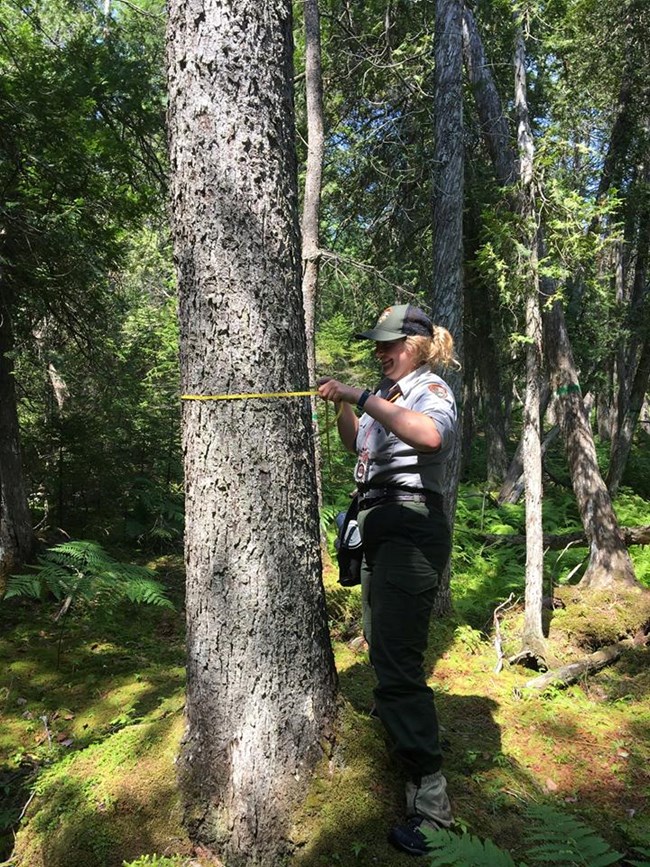Part of a series of articles titled Managing Resilient Forests Initiative for Eastern National Parks.
Article
I&M Networks Support Resilient Forest Management

NPS image
National Park Service scientists in the northeast recently launched the Resilient Forests Initiative to raise awareness of threats to forest health and foster collaboration across national parks in the Northeast and National Capital Regions. The initiative includes the following four efforts:
Describe Forest Condition
Together with the Schoodic Institute, scientists with the NPS Inventory & Monitoring (I&M) program assessed the current status of forests in eastern U.S. national parks. They used 12 years of data on tree canopy and understory growth from more than 1,400 forest plots established in some 40 regional national parks and historic sites. Each park was assigned to one of four forest regeneration categories: secure, insecure, probably failure, or imminent failure.
Regeneration fell into the imminent or probable failure category for most park forests in the study. Browsing by overabundant white-tailed deer and crowding by invasive plants were identified as the primary causal threats. Study results were published in Ecological Applications in 2023. I&M scientist made management recommendations for individual parks based on their forest condition.
Connect Park Managers
The Resilient Forest Initiative strives to bring together parks facing similar threats and facilitates mutual collaboration around the most pragmatic forest management practices that parks can implement.
In February 2024, two virtual workshops will connect NPS staff and partners from four regions, facilitating the exchange of management options and actions park managers are currently using that promote resilient forests.
The November 2022 Resilient Forest Management training brought together 120 park biologists, Invasive Plant Management Teams, regional leaders, I&M network staff, partners, and collaborators to address the major challenges to northeast and mid-Atlantic park forests. The three-day event connected park managers with available resources to implement resilient forest management. It also built regional collaboration towards sustaining park forests amid a changing climate, overabundant deer, novel pests and pathogens, invasive plants, and altered disturbance regimes.
Recommend Resources and Tools
Collaboration through the Resilient Forest Initiative supports parks in implementing management actions that promote resilient forest ecosystems, including: deer population management, invasive species control, prescribed fire, silvicultural treatments, tree planting, fencing and more.
Through the Bipartisan Infrastructure Law and the Inflation Reduction Act, the Resilient Forest Initiatvie has leveraged over $10 million to invest in over 35 national parks in the eastern US. These projects will improve ecological health on more than 10,000 acres of forest, promoting resilience in ecosystems of high ecological and cultural value that are at the greatest risk of forest loss. As a result, park forests will be more resilient to climate change and disturbances, ensuring they persist for future generations to enjoy.
Support Adaptive Management
The Resilient Forests Initiative supports collaboration between national parks and I&M networks to integrate Inventory & Monitoring data into management decision-making. Long-term monitoring not only tracks the status and trends of forest condition, but creates a framework for steering forest management toward desired goals. In this adaptive management framework, collaboration is encouraged between parks, I&M, regional biologists, and Invasive Plant Management Teams.
For More information
Visit: Resilient Forests Initiative Resources and Support (NPS only)
Contact:
Stephanie Perles
Vegetation Ecologist, Eastern Rivers and Mountains Network
(814)-441-9643
Dowlnoad this Resource Brief
Tags
- acadia national park
- allegheny portage railroad national historic site
- antietam national battlefield
- appomattox court house national historical park
- bluestone national scenic river
- booker t washington national monument
- catoctin mountain park
- chesapeake & ohio canal national historical park
- colonial national historical park
- delaware water gap national recreation area
- eleanor roosevelt national historic site
- fort necessity national battlefield
- fredericksburg & spotsylvania national military park
- friendship hill national historic site
- gauley river national recreation area
- george washington memorial parkway
- george washington birthplace national monument
- gettysburg national military park
- harpers ferry national historical park
- home of franklin d roosevelt national historic site
- hopewell furnace national historic site
- johnstown flood national memorial
- manassas national battlefield park
- marsh - billings - rockefeller national historical park
- minute man national historical park
- monocacy national battlefield
- morristown national historical park
- national capital parks-east
- new river gorge national park & preserve
- petersburg national battlefield
- prince william forest park
- richmond national battlefield park
- rock creek park
- sagamore hill national historic site
- saint-gaudens national historical park
- saratoga national historical park
- thomas stone national historic site
- valley forge national historical park
- vanderbilt mansion national historic site
- weir farm national historical park
- wolf trap national park for the performing arts
- invasive plant management
- resilient forest management
- white tailed deer
- deer management plan
- deer management
- forest health
- region 1
- climate resiliency
- climate change adaptation
- ermn
- vegetation
- midn
- ncrn
- forest
- eastern rivers and mountains network
- mid-atlantic network
- netn
- northeast temperate network
- ncbn
- northeast coastal and barrier network
- national capital region network
- resilient forests initiative
Last updated: August 20, 2024
